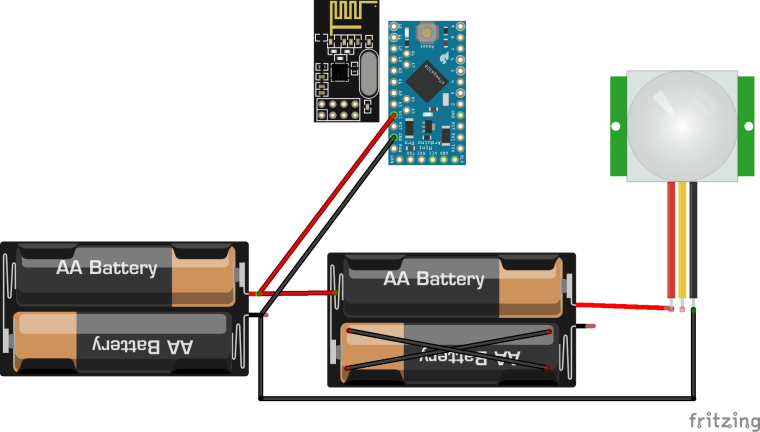HC-SR501 3.3V randomly sends tripped when radio is on
-
@mfalkvidd
Awesome! How do i connect the wires to the battery? Solder them or what? -
@mfalkvidd
Awesome! How do i connect the wires to the battery? Solder them or what? -
@mfalkvidd
And how can i tape the wire on the side of the battery holder? My battery holder package already has two wires connected like in the fritzing pictures. -
@mfalkvidd
And how can i tape the wire on the side of the battery holder? My battery holder package already has two wires connected like in the fritzing pictures. -
@burningstone tape a wire directly on the battery, or solder to the battery or the holder.
Look what you have lying around and be creative!
That's what MySensors is about!@Yveaux
Sorry I have been a long time away due to exams.
Now I finally have time to spend for mysensors :)I tried your approach with the three batteries. My setup looks like this:

I modified the HC-SR501 as shown below:

The sketch is pretty simple, it sends the motion and the light level and then goes to sleep with interrupt for 30 minutes. I still get the false positives whenever the arduino doesn't wake up from intrerrupt.
What am I doing wrong?
-
@Yveaux
Sorry I have been a long time away due to exams.
Now I finally have time to spend for mysensors :)I tried your approach with the three batteries. My setup looks like this:

I modified the HC-SR501 as shown below:

The sketch is pretty simple, it sends the motion and the light level and then goes to sleep with interrupt for 30 minutes. I still get the false positives whenever the arduino doesn't wake up from intrerrupt.
What am I doing wrong?
-
@Yveaux
Sorry I have been a long time away due to exams.
Now I finally have time to spend for mysensors :)I tried your approach with the three batteries. My setup looks like this:

I modified the HC-SR501 as shown below:

The sketch is pretty simple, it sends the motion and the light level and then goes to sleep with interrupt for 30 minutes. I still get the false positives whenever the arduino doesn't wake up from intrerrupt.
What am I doing wrong?
@burningstone You probably want to find the root cause to this but, as a quick fix, have you tried software-blocking the false trip with an additional sleep before the interrupt-activating sleep? Something like
sleep(3000);before the lastsleep(...). I do it with success for my mini-pirs. -
@Yveaux @gohan
I updated the library to 2.2 and I put a 47uf cap between ground and vcc of the pir (hope that's what you mean't) and now it works.Thanks for your help!
I soldered now everything onto a pcb and now the pir doesn't work. I feel like giving up, didn't think that it would be that hard for me to build one stable node. I spent almost 2 hours soldering and assembling and now it doesn't work :(
-
@burningstone You probably want to find the root cause to this but, as a quick fix, have you tried software-blocking the false trip with an additional sleep before the interrupt-activating sleep? Something like
sleep(3000);before the lastsleep(...). I do it with success for my mini-pirs. -
@Yveaux @gohan
I updated the library to 2.2 and I put a 47uf cap between ground and vcc of the pir (hope that's what you mean't) and now it works.Thanks for your help!
I soldered now everything onto a pcb and now the pir doesn't work. I feel like giving up, didn't think that it would be that hard for me to build one stable node. I spent almost 2 hours soldering and assembling and now it doesn't work :(
@burningstone Check connections with a continuity tester and measure your voltages coming to the arduino and PIR. When checking continuity, check directly from the jack on the PIR and/or temp sensor to the pro mini terminals, and also check pins near the connections for any possible shorts.

